 |
  Home | Contact | Site Map |

| Top Destinations |
|
You are here Home » Top Destinations » Uttaranchal
Honeymoon in Uttaranchal India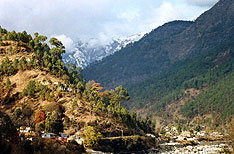 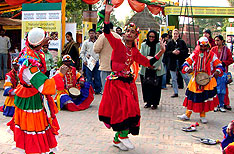 About Uttaranchal Uttaranchal formerly a part of Uttar Pradesh was formed on November 9th, 2000 as the 27th state of the Indian Union. It is one of the most beautiful and enchanting region of northern India. Nature has endowed this land with so much beauty and spiritual bliss that it is also known as Dev Bhoomi, the Land of Gods . Ganga, Yamuna and scores of other rivers originate in Uttaranchal. Among them Ganga is the most holy and prominent as she represents the soul of India- her rich culture, history and civilization. In Sanskrit 'Himalaya' means Abode of Snow, truly characterizing the vast permanent snow fields above the snow line.In the heart of these majestic mountains lies the state of Uttaranchal with Kumaon region in its east and Garhwal in the west. Apart from the Terai region in the Shivalik foothills, the entire state of Uttaranchal is a part of the Himalayan ranges. At 7,817 m above sea level, Nanda Devi in the district of Chamoli is the highest point in the state. The region has many glaciers, passes, meadows, and trekking routes with several major rivers like the Ganga and Yamuna originating from here. A major part of this Himalayan state comes under rainforests and alpine forests that are home to some of the highly endangered wildlife species. HISTORYUttaranchal finds mention in the ancient Hindu scriptures as Kedarkhand, Manakhand and Himavat. The Kushanas, Kudinas, Kanishka, Samudra, Gupta, the Pauravas, Katuris, Palas, the Chandras and Pawaras and the British have ruled in turns. It is often called the Land of the Gods (Dev Bhoomi) because of its various holy places and shrines. The hilly regions of Uttaranchal offer un spoilt landscapes to the tourist -pilgrim. Uttaranchal is an amalgamation of the two hilly divisions of former Uttar Pradesh, Kumaon and Garhwal, the regions that are known according to Hindu legends as Devbhoomi (land of the gods). Both the divisions, though they are spelled in the same breath, show sufficient diversity in their history, culture and ethnicity so much so that they are often considered separately. The Garhwal Himalayas have nurtured civilization from the wee hours of history. It appears to have been a favorite locale for the voluminous mythology of the Puranic period. The traditional name of Garhwal was Uttarakhand and excavations have revealed that it formed part of the Mauryan Empire. It also finds mention in the 7th-century travelogue of Huen Tsang. However, it is with Adi Shankaracharya that the name of Garhwal will always be linked, for the great 8th-century spiritual reformer visited the remote, snow-laden heights of Garhwal, established a math (Joshimath) and resorted some of the most sacred shrines, including Badrinath and Kedarnath. The history of Garhwal as one unified whole began in the 15th century, when king Ajai Pal merged the 52 separate principalities, each with its own garh or fortress. For 300 years, Garhwal remained one kingdom, with its capital at Srinagar (not to be confused with the capital of Kashmir). Then Pauri and Dehradun were perforce ceded to the Crown as payment for British help, rendered to the Garhwalis during the Gurkha invasion, in the early 19th century. Humankind has been around in Kumaon for a very long time. Evidences of Stone Age settlements have been found in Kumaon, particularly the rock shelter at Lakhu Udyar. The paintings here date back to the Mesolithic period. The early medieval history of Kumaon is the history of the Katyuri dynasty. The Katyuri kings ruled from the seventh to the 11th century, holding sway at the peak of their powers over large areas of Kumaon, Garhwal, and western Nepal. The town of Baijnath near Almora was the capital of this dynasty and a center of the arts. Temple building flourished under the Katyuris and the main architectural innovation introduced by them was the replacement of bricks with hewn stone. On a hilltop facing east (opposite Almora), is the temple of Katarmal. This 900-year-old sun temple was built during the declining years of the Katyuri dynasty. The intricately carved doors and panels have been removed to the National Museum in Delhi as a protective measure after the 10th-century idol of the presiding deity was stolen. After an interregnum of a couple of centuries, the Chands of Pithoragarh became the dominant dynasty. The magnificent temple complex at Jageshwar, with its cluster of a hundred and sixty-four temples, was built by the Chand rulers over a duration of two centuries. Dedicated to Lord Shiva, the evocative carvings are complemented by the beautiful cedar forest around it. CULTUREThe culture of the present Kumaon is a blend of influences from the indigenous population as well as from the immigrants to this region. Consequently, the myths, dialects, languages, folk literature, festivals, fairs and forms of artistic expression are examples of the creative influences of the different cultural groups that constitute Kumaon. FAIRS AND FESTIVALSThe world famous Kumbh Mela/Ardh Kumbh Mela is held at Haridwar every twelfth/sixth year interval. Other prominent fairs/festivals are FOLK DANCESBhotiya DanceBhotiya Dance is performed by Bhotias and are connected with death ceremonies. It is believed by them that the soul of the dead person is residing in body of a goat or sheep and by dancing the soul can be liberated. Barada NatiBarada Nati dance is performed during religious festivals or any other social occasion. It is performed by men and women wearing colorful costumes. Pandava DancePandava Dance is performed by narrating the story of Mahabharata accompanied by dance and music. This is performed during Dussehra and Deepawali. Langvir DanceThis is a acrobatic dance performed by men. In this dance the dancer climbs a pole and balances himself at his navel on the top of the pole. Accompanied by dhola and music he balances and rotates on his belly at the pole and performs other acrobatic stunts. ARTS AND CRAFTSSurrounded by the magnificent Himalayas and dense forests lies the land of Uttaranchal. The snow-clad region is famous for its temple architecture, wood carving, paintings and traditional ornaments. The peace and tranquility of Uttaranchal laid the foundation for a treasure house of paintings and art. Out of the two major art forms, the art of stone carving and woodcarving are fairly well known. The art of stone carving gradually died down, but woodcarving continued. Woodcarving could be seen on almost every door of a Garhwali house until only half a century ago. Woodcarving can still be seen in hundreds of temple all over Garhwal. The remains of architectural work have been found at the Chandpur Fort, temple of Srinagar, Pandukeshwar (near Badrinath), Devi Madin (near Joshimath), and Devalgarh Temple. FOLK MUSICMadhya Desh was the land of the great sages and hermits and the singing of ancient hymns and mantras laid the basic tradition of music, which has blossomed into a musical tradition. The ages of Guptas and Harsh Vardhan were the peaks of music in Uttar Pradesh in the past. The medieval age saw the emergence of two distinct strands of music. One was the court music that found patronage in the Courts like Agra, Fatehpur-Sikri, Lucknow, Jaunpur, Varanasi, Ayodhya, Banda and Datiya. The second was the religious tradition emerging from the Bhakti Cult rooted and flowered in centres like Mathura, Vrindavan and Ayodhya. Rulers and musicians from Uttar Pradesh contributed to the prosperity of Hindustani music. FLORA AND FAUNAThe alpine and tropical rainforests that cover most parts of the state make natural habitats of some of the best-known wildlife creatures India has on offer. The Jim Corbett National Park is home to Royal Bengal Tigers and ground for the plot of Jim Corbett's Man-eaters of Kumaon . Another rainforest in the region is Rajaji National Park famous for its large number of pachyderms. Alpine forests in the region include Valley of Flowers National Park (known for its amazing variety of flowers), Nanda Devi National Park, Govind National Park, Gangotri National Park, and many more. General Information of Uttaranchal LOCATIONUttaranchal is a part of the Western Himalayan ranges starting from the Shivalik foothills to Greater Himalayas with Tibet as its northeastern border. In the northwestern corner of the state is Himachal Pradesh, while Haryana celebrates its union with the newly formed state with a gentle kiss. The state is surrounded by Uttar Pradesh from most of its western and southern boundary. Punjab on the west, Uttar Pradesh on the southeast, China on the east, Haryana on the southeast, and Jammu and Kashmir on North border the Indian state of Himachal Pradesh. It extends from the latitudes 30?22'40" North to 33?12'40" North and longitudes 75?45' 55" East to 79?04' 20" East. How to Reach By AirJolly Grant near Dehradun is the only airport. There are regular flights to Delhi by Indian Airlines. Otherwise, one has the option to travel to Delhi by road or rail and then take the air route to various destinations. By RailDehradun, Haridwar, and Kathgodam are the major railway stations connected to almost all parts of f the country with regular trains. Not many places in the state are connected by rail because of tough terrains. For those visiting places in the higher altitudes, trekking and road routes are the only options available. By RoadAlmost all the important places in the state are connected by all-weather metalled roads. Many places in the higher altitudes may still remain off for a period in the year due to landslides and snowfall. National Highways such as 58, 73, 74, and 87 connect places in the state to other parts of the country. Regular bus services connect Delhi and other major centers in North India with Dehradun. The road distances of some prominent destinations from Dehradun are as follows: Mussoorie- 35 km; Delhi-255 km; Haridwar, 54 km; Rishikesh-43 km; Shimla- 221 km; Nainital- 485 km; Kedarnath-270 km; Badrinath- 344 km; Gangotri-301 km; Yamunotri- 265 km; Chakrata- 92 km; Corbett National Park- 236 km; Valley of Flowers and Hemkund- 342 km. BEST TIME TO VISIT The state has two distinct climatic regions: the predominant hilly terrain and the small plain region. The climatic condition of the plains is very similar to its counterpart in the Gangetic plain-that is, tropical. Summers are unbearable with temperature going over the 40?C mark and a lot of humidity. Winters can be chilly with temperatures going below 5?C at times. The Himalayan region has Alpine conditions characterized by cold winters with snowfall for quite a long time, good rainfall in the monsoon, and mild summers. This climate also provides the state with its only livelihood, i.e., tourism. Tourist Attractions in Uttaranchal Dehradun
The idyllic location of Dehradun endows it with a pleasant climate that makes the city a popular getaway in the summers. The places of interest in Dehradun include Robber's Cave, Tapkeshwar Temple, Tapovan, Malsi Deer Park, Kalinga edicts built by Emperor Ashoka, Buddhist Monastries and Forest Research Institute. The Central Braille Press or Rashtriya Drishtibaditarth Sansthan Bharat is the largest producer of Braille texts in India. As a Hill Station in India, Dehradun is also home to the famed schools of the order of Doon School and Welhams as elite centers of learning in India. Apart from being a much sought after Hill Station in India, they qualify Doon valley to be a star class educational center. Dhanaulti Dhanaulti located amidst thick, virgin forests of deodar, rhododendron and oak has an atmosphere of perfect peace & tranquility. The long wooded slopes, lazy outings, cool caressing breeze, warm and hospitable inhabitants, lovely weather and fabulous view of snow covered mountains makes it an ideal retreat for a relaxed holiday. Situated on the Mussoorie - Charfiba route, Dhanaulti is 25 km. from Mussoorie. Joshimath Joshimath the name Joshimath is a corruption of the Sanskrit word ?Jyotirmath? the place of Jyotirlinga of Shiva. Shankracharya founded one of the four piths ?Centres? for sanyashis here. It is a halting place for the pilgrims bound for Badrinath. It is considered to be one of the most sacred places by Hindus who believes that Badrinath (The God Vishnu) resides here in winter. Kausani
There are many tourist places in and around Kausani that can be enjoyed by tourists. The famous poet Sumitra Nandan Pant was born in Kausani. The poet's house has been converted into the Pant Museum and contains articles, drafts of his poems, letters and awards belonging to the poet. Pinakeshwar, 9050 feet above sea level, is a small hill station 20 kms from Kausani. Here there is a temple of Shiva from where one can view many valleys. Around Pinakeshwar are other places like Old Pinakeshwar, Gopalkot and Huria. Valley of Flowers The Valley of Flowers is a U-shaped alpine valley formed by the retreating glaciers in the Garhwal region. The Valley remains covered by snow for most part of the year from November to May. From June onwards, when the snow melts, the Valley of Flowers is splashed with several colors. The valley is then colored with medicinal herbs and flowering plants. The best time to visit the valley of flowers is between mid July - mid August. The fauna at the Valley of Flowers include the Himalayan Musk Deer and yellow Marten. . It is believed that black bear, brown bear, Himalayan tahr, blue sheep and snow leopard also frequent this area. Almora The cultural capital of Kumaon, Almora is one of the three hill districts of Kumaon. The other two districts are Nainital and Pithoragarh. Almora owing to its natural splendor is referred to as the unspoilt child of nature. Almora is situated on a three-mile long horse-shoe shaped ridge and is surrounded by four hill ranges - Banari Devi, Shayahi Devi, Kasar Devi and Katarnal. The first three peaks have temples of Godesses while Katarnal has an ancient Sun Temple. Bageshwar and Sitalakhet are other places of interest. Bageshwar is one of the main camping sites for the journey to Pindari Glacier, which is situated at a height of 3,820 meters. Kafni Glacier is also close by (3,860 meters) and Sitalakhet is an upcoming tourist resort on the Shayahi Devi hill. Ranikhet
There are a number of places to visit near Ranikhet. The famous tourist center of Nainital is 59 km from Ranikhet. Nainital is famous for its Naini Lake and a number of picnic spots in and around it. Almora is 50 km from Ranikhet, is famous for its health resorts and panoramic views of the Himalayan ranges. Dwarahat, 38 km away, was once the principal seat of the Katyuri Rajas. It is full of ancient sculptures. Sitalakhet (35 km), Tarikhet (8 km) and Khairna (22 km) are some of the places that one can visit from Ranikhet. Mukteshwar Mukteshwar in the Kumaon region of Uttaranchal is located at a height of 2286 meters above sea level. Mukteshwar is located at a distance of 42 km from Haldwani and 51 km from Nainital. Pauri Pauri is located in the Garhwal region of Uttaranchal. Pauri is a land with splendid views of the snow peaks of Himalayas, scenic valleys, meandering rivers, dense forests and beautiful people. With a diverse topography, the district of Pauri Garhwal consists of the foothills of the Kotdwara and the sprawling meadows of Dhudatoli rising to a height of 3000 meters. Dhudatoli remains covered by snow through the winter months. Pauri is an excellent stopover in Uttaranchal from where you can tour many nearby places. Khirsu with its snow covered peaks offer a panoramic view of the Central Himalayas and attracts a large number of tourists. Located just 19 km from Pauri, Khirsu has an elevation of 1700 meters offering a peaceful spot, free from pollution. The ancient temple of Ghandiyal Devta in the vicinity is worth a visit. Adwani, 17 km from Pauri is an excellent picnic spot, surrounded by thick forests. Mussoorie
Chopta Chopta is situated on the Gopeshwar - Ukhimath road, about 40 km from Gopeshwar. Located at a height of about 2900 meters above sea level, Chopta is one of the most picturesque locales in the Garhwal region of Uttaranchal. Chopta provides a panoramic view of the Himalayas and the surrounding areas. Ukhimath, 31 km from Chopta is the Winter Seat of Lord Kedarnth. In winters due to the snow, the temple of Kedarnath remains closed and the idol is shifted here where the worship is held. The temples of Usha and Anirudh, Shiva and Parvati are also crowd pullers. Chamoli Chamoli, the abode of Gods, reputed for its shrines and temples, birth place of 'Chipko Movement ' with its strategic significance is one of the hill district of Uttaranchal, India. Chamoli proved itself " the most spectacular in its natural assets ; be it maintain scenery , valley aspects, water-edges, floristic varieties, dramatic landform or the climatic cardinalities. Nainital
Haridwar Haridwar has very rich ancient religious and cultural heritage. in the ancient scriptures of India, this place is well known by the name of Mayapur. This city is also well known for many other things apart from the holy river Ganges. Haridwar has privilege of having IIT at Roorkee, formerly known as University of Roorkee, founded in 1847 as a first technical institute of India. |
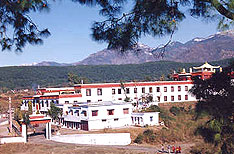 Dehradun is one of the oldest cities of India and the Provisional Capital of Uttaranchal. Located at a height of 2,200 feet above sea level and nestled in the Himalayas, the beautiful Doon Valley is known as the "Abode of Drona". Dehradun is a popular tourist destination owing to its natural beauty and numerous religious and historical places.
Dehradun is one of the oldest cities of India and the Provisional Capital of Uttaranchal. Located at a height of 2,200 feet above sea level and nestled in the Himalayas, the beautiful Doon Valley is known as the "Abode of Drona". Dehradun is a popular tourist destination owing to its natural beauty and numerous religious and historical places.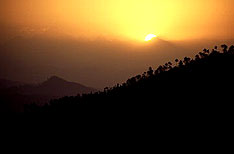 Originally known as Valna, Kausani is one of the hill stations in Uttaranchal that offers unmatched views of the mountains. The land of deep pine trees and majestic mountains, Kausani is also known as the 'Switzerland of India'. Kausani offers uninterrupted views of the snow peaks, Nanda Devi and Trishul. With a favorable climate, tourists prefer Kausani round the year.
Originally known as Valna, Kausani is one of the hill stations in Uttaranchal that offers unmatched views of the mountains. The land of deep pine trees and majestic mountains, Kausani is also known as the 'Switzerland of India'. Kausani offers uninterrupted views of the snow peaks, Nanda Devi and Trishul. With a favorable climate, tourists prefer Kausani round the year.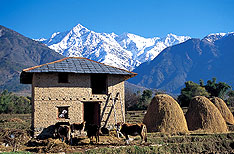 Ranikhet is a quaint little hill station tucked in the hills of Uttaranchal. Conceived by the British, Ranikhet has an old army cantonment from the British era. Ranikhet is a little town with unspoilt natural beauty.
Ranikhet is a quaint little hill station tucked in the hills of Uttaranchal. Conceived by the British, Ranikhet has an old army cantonment from the British era. Ranikhet is a little town with unspoilt natural beauty.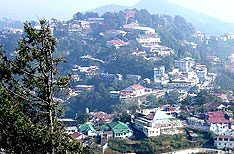 Mussorie is popularly known as the "Queen of the Hills". This beautiful hill station is just 34 km from Dehradun and is located at an altitude of 2003 meters above sea level. One of the most beautiful hill stations of India, Mussoorie is a favorite of most of the North Indians. Just a few hours away from Delhi, Mussorie is also preferred as a weekend getaway during the summer months. For people who like to mix pleasure with business, Mussoorie is an ideal destination. Mussoorie is also close to the major pilgrimage sites of Uttaranchal like Kedarnath, Badrinath, Gangotri, Yamunotri, Haridwar and Rishikesh.
Mussorie is popularly known as the "Queen of the Hills". This beautiful hill station is just 34 km from Dehradun and is located at an altitude of 2003 meters above sea level. One of the most beautiful hill stations of India, Mussoorie is a favorite of most of the North Indians. Just a few hours away from Delhi, Mussorie is also preferred as a weekend getaway during the summer months. For people who like to mix pleasure with business, Mussoorie is an ideal destination. Mussoorie is also close to the major pilgrimage sites of Uttaranchal like Kedarnath, Badrinath, Gangotri, Yamunotri, Haridwar and Rishikesh.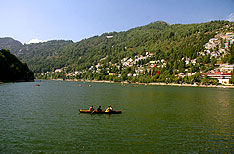 Nainital is the land of green hills and lakes. Perhaps one of the most popular hill stations in North India, Nainital is also known for its many legends and stories. There are hundreds of ancient temples and peaks with outstanding views of the mountains in the background that add to Nainital's evergreen charm.
Nainital is the land of green hills and lakes. Perhaps one of the most popular hill stations in North India, Nainital is also known for its many legends and stories. There are hundreds of ancient temples and peaks with outstanding views of the mountains in the background that add to Nainital's evergreen charm.